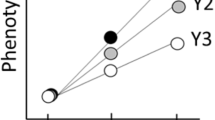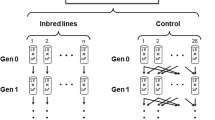Abstract
IT has been suggested1–4 that organisms with a haplodiploid sex determination system should have reduced genetic variability relative to diploid organisms. In haplodiploid systems such as in bees and wasps (Hymenoptera), unfertilised eggs develop into haploid males and fertilised eggs into diploid females. Thus the frequency with which alleles are exposed to selection in an effectively homozygous state is increased over comparable diploid species. A lower level of genetic variation would be expected for haplodiploid organisms, relative to diploid organisms, for that genetic variation which is not neutral and is expressed in the haploid sex. Thus, measurement of the level of genetic variability in haplodiploid species is of considerable interest in understanding the mechanisms responsible for maintaining the high levels of genetic polymorphism in diploid organisms5,6. For this reason, we have measured the genetic variability in haplodiploid species using the combined techniques of electrophoresis and histochemical staining7,8. As predicted by selection theory, we have shown that the Hymenoptera (haplodiploid organisms) have a lower level of genetic heterozygosity and a lower frequency of enzyme polymorphism than do diploid organisms.
This is a preview of subscription content, access via your institution
Access options
Subscribe to this journal
Receive 51 print issues and online access
$199.00 per year
only $3.90 per issue
Buy this article
- Purchase on Springer Link
- Instant access to full article PDF
Prices may be subject to local taxes which are calculated during checkout
Similar content being viewed by others
References
White, M. J. D., Animal Cytology and Evolution (Cambridge University Press, Cambridge, 1954).
Suomalainen, E., Ann. Rev. Entomol., 7, 349–366 (1962).
Askew, R. R., Evolution, 22, 642–645 (1968).
Crozier, R. H., Genetica, 41, 551–556 (1970).
Harris, H., Proc. R. Soc., B 164, 298–310 (1966).
Lewontin, R. C., and Hubby, J. L., Genetics, 54, 595–609 (1966).
Hunter, R. L., and Markert, C. L., Science, 125, 1294–1295 (1957).
Shaw, C. R., and Prasad, R., Biochem. Genet., 4, 297–320 (1970).
Lewontin, R. C., The Genetic Basis of Evolutionary Change, (Columbia University Press, Columbia, 1974).
Battaglia, B., Proc. eleventh int. Congr. Genet., 2, 451–463 (1965).
Powell, J. R., Science, 174, 1035–1036 (1971).
Selander, R. K., and Kaufman, D. W., Proc. natn. Acad. Sci. U.S.A., 70, 1875–1877 (1973).
Author information
Authors and Affiliations
Rights and permissions
About this article
Cite this article
METCALF, R., MARLIN, J. & WHITT, G. Low levels of genetic heterozygosity in Hymenoptera. Nature 257, 792–794 (1975). https://doi.org/10.1038/257792a0
Received:
Accepted:
Issue Date:
DOI: https://doi.org/10.1038/257792a0
This article is cited by
-
Isoenzyme Variation in Melipona rufiventris (Hymenoptera: Apidae, Meliponina) in Minas Gerais State, Brazil
Biochemical Genetics (2005)
-
High genetic variability despite haplodiploidy in primitive sawflies of the genusCephalcia (Hymenoptera, Pamphiliidae)
Experientia (1996)
-
Genetic differentiation between two host ?races? and two species of cleptoparasitic bees and between their two hosts
Biochemical Genetics (1995)
-
A comparison of genetic variation in two sibling species pairs of haplodiploid insects
Biochemical Genetics (1993)
-
A comparison of genetic variation in two sibling species pairs of haplodiploid insects
Biochemical Genetics (1993)
Comments
By submitting a comment you agree to abide by our Terms and Community Guidelines. If you find something abusive or that does not comply with our terms or guidelines please flag it as inappropriate.



